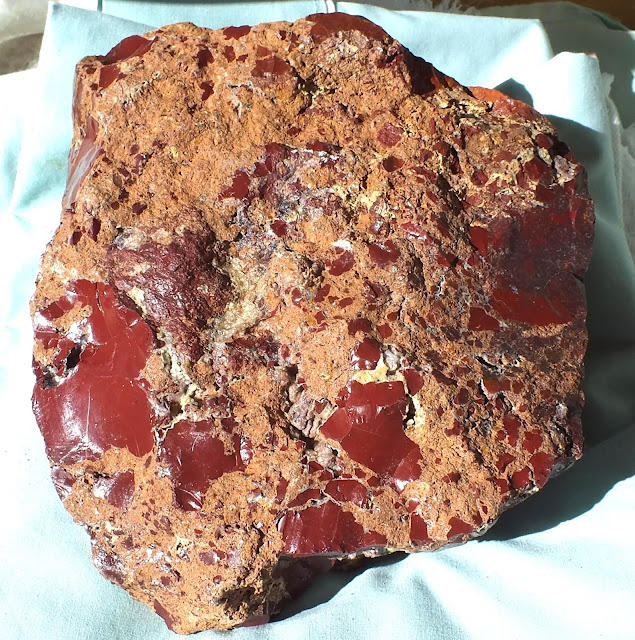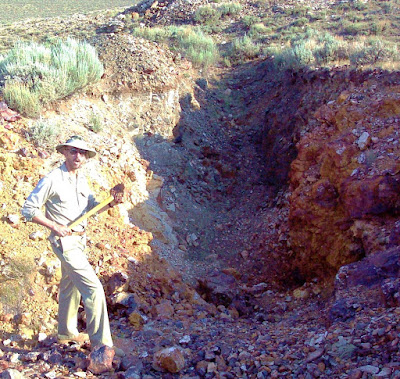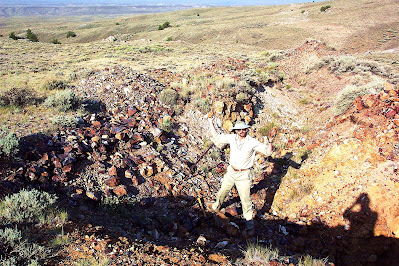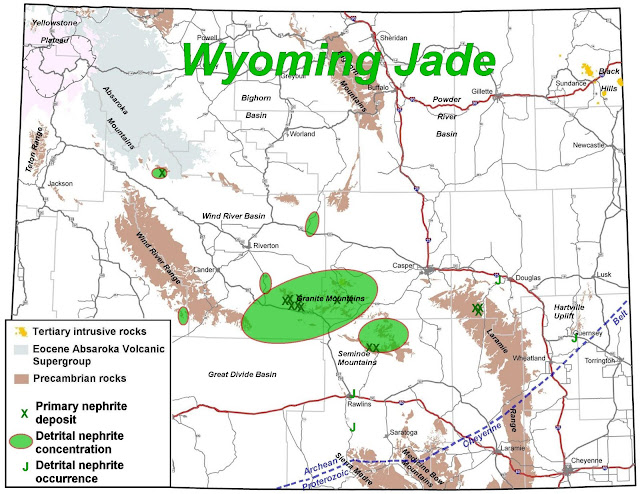 |
| Never seen so much jasper! Tonnes and tonnes of jasper in the Tin Cup district, yet much of the area remains to be prospected. Some jasper was exposed in old prospect pits, while considerable jasper trends along strike lying under inches of soil. All of this on public land administered by the BLM (Bureau of Land Management). You can follow these dike-like occurrences of massive jasper for hundreds of feet. In the same area, are low-quality nephrite jade, some rare jade pseudomorphs after quartz, rubies, sapphires, agate, and pyrite. These deposits in central Wyoming, lie north of the Jeffrey City almost ghost town. |
JASPER - Some things you should know about jasper: (1) Do you know how many different varieties of jasper are recognized? (2) What rock formations in America contain chert (agate, jasper, flint, chalcedony, etc)? (3) Where is jasper found? (4) Do you know how many times jasper is mentioned in the Holy Bible? (5) Everything you need to know about jasper; (6) Pick a state in the US where jasper is found; (7) GemHunter's guide to Agate and Jasper.
TIN CUP DISTRICT - Just how much jasper is in the Tin Cup district? Don't know, but suspect it may be one of the larger deposits in North America! When you visit scatter prospects in the district, it is clear most are likely interconnected. When you walk over the ground in-between prospects, you will find thin soil cover with periodic chips, fragments and pieces of the lapidary mineral in the dirt. SO, potentially, there could be considerable tonnage buried under just inches to a few feet of soil.
42°38'57"N; 107°53'15"W) that are outlined by white granitic dikes and pegmatites in dark schist. The fold noses are potential sites for mineral enrichment, if any mineralizing fluids were released during regional metamorphism of the Granite Mountains. The district is also extensively faulted and fractured with a number of interesting minerals found nearby. While exploring for jade and corundum in this area, examples of distinct hydrothermal alteration was recognized with most in-situ jade deposits. So, there is potential for hydrothermal and metamorphogenic gold in the Granite Mountains, and there still is a lot of geology to examine in the region!
 |
| Photo by Wayne Sutherland showing massive to brecciated jasper in the wall of the prospect, with geologist for scale. |
The nearby Sweetwater shear zone (42°37'5"N; 107°54'16"W) forms a N65oE-trending shear structure that can be traced for 3 miles on trend. Locally, it is as much as 0.25 to 0.5 mile wide with numerous shear fractures, foliation, and rock cleavage. These all potentially provide permeable pathways for mineral fluids mobilized during regional metamorphism (2.8 Ga) of the Granite Mountains.
Another shear structure is visible in a granitic inselberg west of Tin Cup Mountain, where the N55oW-trending, Tin Cup shear (42°39'13"N; 107°55'42"W) is visible on aerial photography. The region has potential, but is mostly unexplored even to this day.
JADE - Other interesting minerals in the region include nephrite-jade pseudomorphs after quartz. Nephrite is a calcium-, magnesium-, iron-rich silicate (amphibole) of the formula: Ca2(Mg,Fe)5Si8O22(OH)2 that forms masses while crystallizing in the monoclinic crystal system. While exploring this region, specimens of nephrite jade with interesting crystal habits were collected. These include jade specimens with quartz (a hexagonal mineral).
 | ||
|
 |
| Grass-green nephrite jade with pyramidal (hexagonal) quartz, Tin Cup district, Wyoming |
 |
| Hexagonal jade pseudomorph after quartz, Granite Mountains, Wyoming. |
 |
| Crystals of nephrite jade mimicking crystal habit of quartz. These hexagonal specimens likely formed by nephrite replacing a vug of quartz crystals (Tin Cup district, Wyoming). |
REFERENCES:
Beeler, H.C., 1907, Prospecting in the Black Canyon-Long Creek vicinity near the Sweetwater River, Fremont County, Wyoming: Wyoming State Geologist Report, Cheyenne, Wyoming, 12 p.
Hausel, W.D., 2014, A Guide to Finding Gemstones, Gold, Minerals and Rocks: GemHunter Publications, 368 p.
Hausel, W.D., and Hausel, E.J., 2011, Gold - A Field Guide for Prospectors and Geologists (Wyoming Examples), GemHunter Publications, 366 p.
Love, J.D., 1970, Cenozoic Geology of the Granite Mountains area, Central Wyoming: US Geological Survey Professional Paper 495-C, 154 p.




.JPG)

.JPG)
+-+Copy.JPG)
.JPG)







